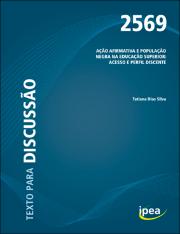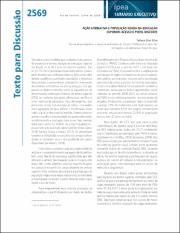Please use this identifier to cite or link to this item:
https://repositorio.ipea.gov.br/handle/11058/10102Full metadata record
| DC Field | Value | Language |
|---|---|---|
| dc.contributor.author | Silva, Tatiana Dias | - |
| dc.coverage.spatial | Brasil | pt_BR |
| dc.date.accessioned | 2020-06-30T19:03:44Z | - |
| dc.date.available | 2020-06-30T19:03:44Z | - |
| dc.date.issued | 2020-06 | - |
| dc.identifier.uri | http://repositorio.ipea.gov.br/handle/11058/10102 | - |
| dc.description.abstract | Este texto tem como objetivo analisar transformações no acesso e no perfil do corpo discente no ensino superior. O fio condutor da análise é a participação da população negra nessa etapa educacional, concentrando a investigação no ensino superior federal, sobre o qual incide a Lei de Cotas no ensino superior (Lei nº 12.711/2012). Para empreender essa análise, procurou-se sistematizar o perfil discente por meio de dados disponibilizados pela Pesquisa Nacional por Amostra de Domicílios (PNAD) Contínua e pelo Censo da Educação Superior (CES) para 2017. Com base nas estimativas da PNAD, foi possível verificar a ampliação da participação de negros na frequência do ensino superior, tanto público como privado. Nos dados do CES, em que pese a alta subnotificação do quesito racial, é possível identificar, em instituições federais de ensino superior (IFES) selecionadas, relevante Índice de Inclusão Racial (IIR). Quando analisados cursos de alta concorrência, na análise regional, a participação de negros decresce comparativamente à representação na população geral. Verifica-se que o percentual de ingressos por meio de vagas reservadas passou de 13% para mais de 39% entre 2012 e 2017. A participação dos ingressantes por meio de vagas reservadas, em geral, é maior nos cursos de maior concorrência. Um aspecto a se considerar é que, provavelmente, o ingresso dos grupos-alvo de fora do sistema de cotas seja menor para os cursos mais concorridos, o que acaba por se concentrar nas vagas reservadas. Esse ponto, todavia, carece de outras investigações. As análises empreendidas permitem alguns desdobramentos. Os dados raciais disponíveis no CES precisam ser aprimorados, a fim de se cumprir a contento a diretiva legal de acompanhamento da política de reserva de vagas. A despeito disso, há oportunidade de análises detalhadas que contribuam com a avaliação e aperfeiçoamento da política. | pt_BR |
| dc.language.iso | pt-BR | pt_BR |
| dc.publisher | Instituto de Pesquisa Econômica Aplicada (Ipea) | pt_BR |
| dc.title | Ação afirmativa e população negra na educação superior : acesso e perfil discente | pt_BR |
| dc.title.alternative | Texto para Discussão (TD) 2569 : Ação afirmativa e população negra na educação superior : acesso e perfil discente | pt_BR |
| dc.type | Texto para Discussão (TD) | pt_BR |
| dc.rights.holder | Instituto de Pesquisa Econômica Aplicada (Ipea) | pt_BR |
| dc.source.urlsource | http://www.ipea.gov.br | pt_BR |
| dc.location.country | BR | pt_BR |
| dc.description.physical | 47 p. : il. | pt_BR |
| dc.subject.vcipea | IPEA::Educação. Treinamento::Sistemas Educacionais::Níveis de Ensino::Ensino Superior | pt_BR |
| dc.subject.vcipea | IPEA::Demografia. População::Grupos Étnicos::Raças::Negros | pt_BR |
| dc.subject.vcipea | IPEA::Educação. Treinamento::Desenvolvimento da Educação. Política Educacional::Acesso à Educação::Acesso à Educação | pt_BR |
| dc.rights.license | É permitida a reprodução deste texto e dos dados nele contidos, desde que citada a fonte. Reproduções para fins comerciais são proibidas. | pt_BR |
| dc.subject.keyword | Ação afirmativa | pt_BR |
| dc.subject.keyword | Ensino superior | pt_BR |
| dc.subject.keyword | Cotas | pt_BR |
| dc.subject.keyword | População negra | pt_BR |
| ipea.description.objective | Analisar transformações no acesso e no perfil do corpo discente no ensino superior, cuja análise é a participação da população negra nessa etapa educacional. | pt_BR |
| ipea.description.additionalinformation | Série monográfica: Texto para Discussão ; 2569 | pt_BR |
| ipea.description.additionalinformation | Possui referências bibliográficas; | pt_BR |
| ipea.description.additionalinformation | Possui apêndice; | pt_BR |
| ipea.access.type | Acesso Aberto | pt_BR |
| ipea.rights.type | Licença Comum | pt_BR |
| ipea.englishdescription.abstract | This text aims to analyze changes in access and the profile of the student body in higher education. The guiding line of the analysis is the participation of the black population in this educational level, concentrating the research in federal higher education, which focuses on the Higher Education Quota Law (Law n. 12.711/2012). In order to undertake this analysis, we sought to systematize the student profile through data provided by the National Continuous Household Sample Survey (PNAD) and the Higher Education Census (CES) for 2017. Based on the estimates of the Pnad, it was possible to verify the increase in the participation of blacks in the attendance of higher education, both in public and private sector. In the CES data, in spite of the high underreporting of the racial question, it is possible to identify, in selected Federal Institutions of Higher Education (IFES), relevant Racial Inclusion Index (IIR). When analyzing highly competitive courses, in the regional view, the participation of blacks decreases comparatively in relation to representation in the general population. The percentage of new students selected by quota system increased from 13% to over 39% between 2012 and 2017. In general, the participation of new entrants through quotas is higher in the most competitive courses. One thing to consider is that the entry of target groups from outside the quota system is likely to be lower for the most competitive courses, which eventually concentrates on reserved seats. This point, however, needs further investigation. The analyzes undertaken allow some developments. The racial data available at CES needs to be improved in order to comply with the legal policy directive. Nevertheless, there is an opportunity for detailed analysis to contribute to policy evaluation and improvement. | pt_BR |
| ipea.researchfields | N/A | pt_BR |
| ipea.classification | Demografia. População | pt_BR |
| ipea.classification | Educação | pt_BR |
| Appears in Collections: | Demografia. População: Livros Educação: Livros | |
Files in This Item:
| File | Description | Size | Format | |
|---|---|---|---|---|
| td_2569.pdf | 2.04 MB | Adobe PDF |  View/Open | |
| td_2569_sumex.pdf | 557.9 kB | Adobe PDF |  View/Open |
Items in DSpace are protected by copyright, with all rights reserved, unless otherwise indicated.

